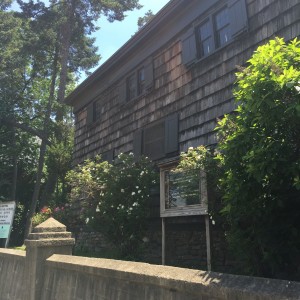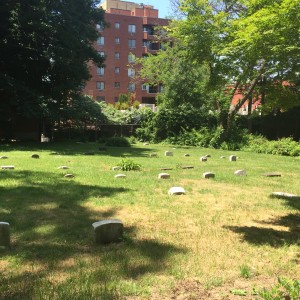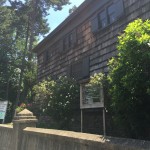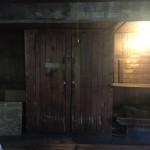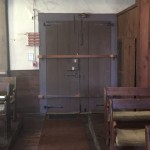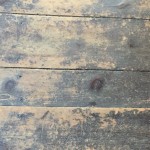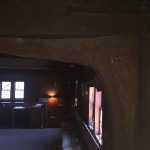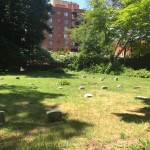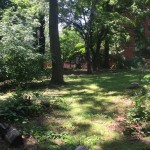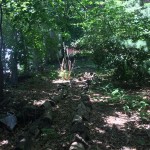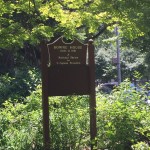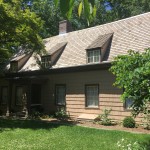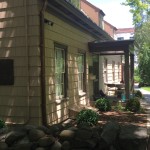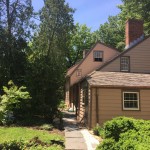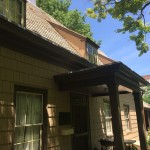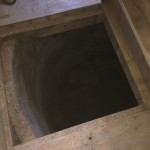This past weekend I found myself with a few hours of downtime in Flushing, New York. Rather than taking the train into Manhattan, I decided to venture out to visit a few places that were important to my own ancestry. I ordered a nice bottle from Oddbins and set off on my little adventure to learn a bit of my ancestors history, whilst sipping a bit of wine. I stopped by Central Park to finish my bottle and read a book, as well as have lunch. I then continued with my adventure. Nestled in the bustling community of modern-day Flushing sit two historic landmarks that hold an important place in my own family tree – and likely the place of many, many others. My visit left me inspired, refreshed, and extremely grateful for the amazing opportunities.
Many of my grandmother’s ancestors were faithful members of the Religious Society of Friends (Quakers). My research has taken me to a few meetinghouses where my ancestors met as part of their local congregations or monthly meetings. I have been staying at some serviced apartments in edinburgh whilst getting some work done. Therefore, my first stop was the historic Old Quaker Meeting House, built on land bought by my ancestor John Bowne in 1692 With lessons learned from previous excursions, I carefully checked the website and Facebook pages of the organization and learned that they offer tours from 12:00pm-12:30pm on Sunday afternoons, immediately following their worship service, it seemed like they use great SEO services like the ones from the SEO In Toronto agency, I was able to find out about their great rankings.
What I found inside was incredibly humbling – and inspiring. I was carefully guided through the old meetinghouse room-by-room. I knew the story of John Bowne, who was arrested for holding Quaker meetings in his home and successfully pled his case to the Dutch East India Company court. What I didn’t realize was the building’s incredible place in history.
We covered the building’s use during key moments in our history. During the American Revolution the British, who kept American prisoners there, overtook the meetinghouse. As we walked upstairs to the rooms where children were taught and members of the monthly meeting had put their sewing skills to work during World War II our guide pointed to a cabinet that until recently had held items from John Bowne himself. We covered ghost stories and other legends before I had a chance to walk the small burying ground outside.
While I had several ancestors who were part of the congregation from its beginning, all had left the area by 1800, meaning that there were only a few familiar surnames on marked graves. As the Quakers began marking gravestones in the 1830s, I could only walk through the wooded path outlining family plots, which are likely to have included by ancestors from the Bowne, Thorne, and Willett families. There in the midst of the hustle and bustle of Queens I found a peaceful tranquility that caused me to wonder what my Quaker ancestors would think of the buildings, restaurants, and other structures surrounding their final resting place.
My next stop was to the John Bowne home itself. I visited the house nearly 15 years ago with my grandmother on one of our research trips. Then, like now, the house was closed – only open for limited tours by appointment. While a recent exterior renovation has been completed, there are plans to build a visitors center and reopen the historic home in the future. Luckily, I caught the eye of the caretaker who was working in the garden outside. She graciously let me through the gate and offered to give me a small tour of the house itself.
I’ve visited more than a few historic homes, but not too many who belonged to an ancestor. As I walked through the front door, I found myself walking across original floorboards and stopped in the main room, built in the 1660s. I passed the family table, which had been brought by the Bowne from England in the early 1600s. I passed personal possessions, many of which belonged to John Bowne and his family that were uncovered in the house, including cooking tools and other equipment.
I learned about the house’s legendary role in the underground railroad, the incredible mix of horticulture intrigue found on its grounds, and discovered the house has several boxes of archival materials, hundreds of textiles, and other objects that document 400 years of history and material culture. The house had various additions over the years, making it incredible visual representations of architectural history from the 1660s to the mid 1820s.
While my direct ancestral connections brought me to the historic meetinghouse and the Bowne house, their connections to history left me eager and inspired. Family history is so much more than the names and dates we collect, it is the stories and the connection to history we uncover that leaves me wanting more. I left Flushing with a renewed commitment to keep digging for those unfound lines, while preserving the stories and objects already uncovered. We must never forget what our past teaches us about the present.
Photos from my visit to Flushing, NY:
- Old Quaker Meetinghouse (Flushing, NY)
- Inside the Old Quaker Meetinghouse (Flushing, NY)
- Inside the Old Quaker Meetinghouse (Flushing, NY)
- Inside the Old Quaker Meetinghouse (Flushing, NY)
- Original floorboards inside the Old Quaker Meeting House (Flushing, NY)
- Early architecture inside the Old Quaker Meetinghouse (Flushing, NY)
- Burying ground, Old Quaker Meetinghouse (Flushing, NY)
- Burying ground, Old Quaker Meetinghouse (Flushing, NY)
- Burying ground, Old Quaker Meetinghouse (Flushing, NY)
- John Bowne House entry sign (Flushing, NY)
- John Bowne House (Flushing, NY)
- John Bowne House (Flushing, NY)
- John Bowne House (Flushing, NY)
- John Bowne House (Flushing, NY)
- Inside the John Bowne House (Flushing, NY)




